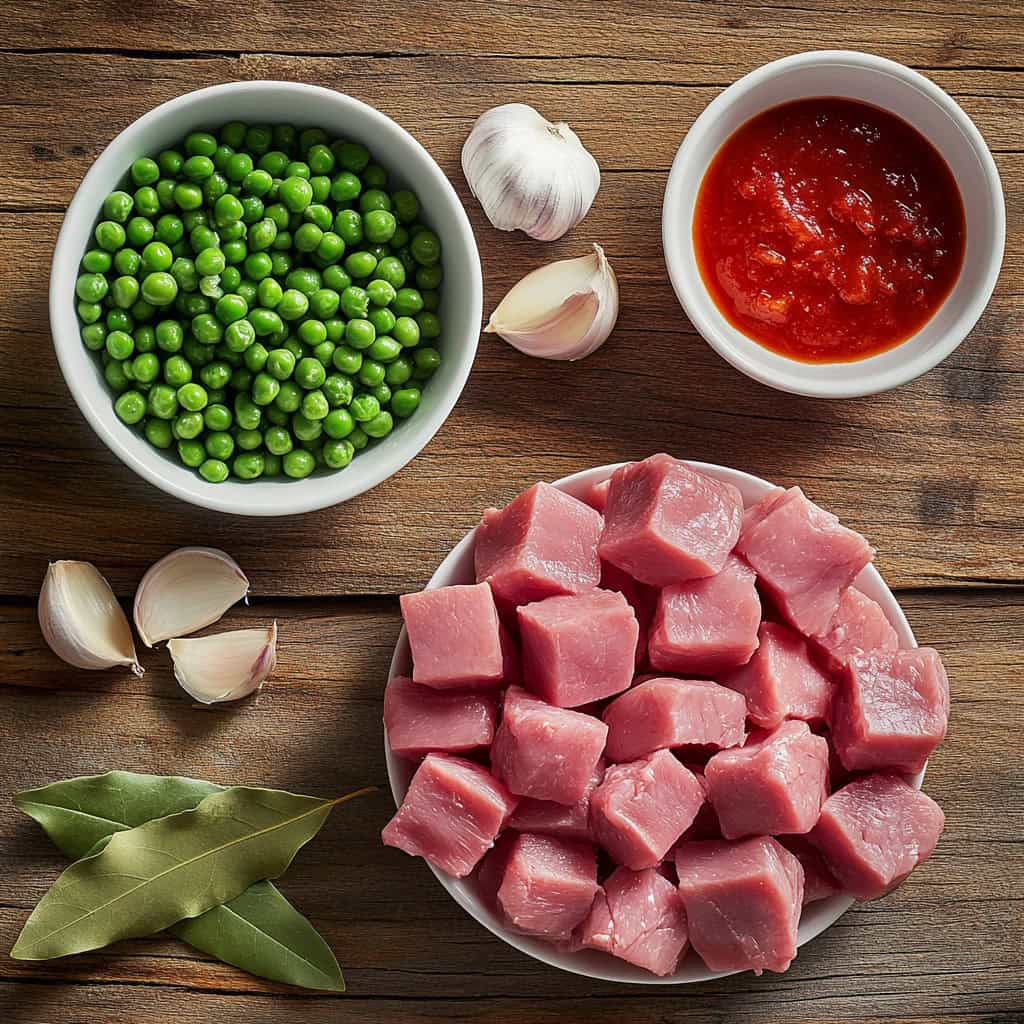I learned this cherished Pork Guisantes recipe during my time volunteering at an orphanage in Orion, Bataan, where Ate Cynthia, our head cook, would prepare this heartwarming dish every Wednesday for over 30 children.
The aroma of garlic and tomatoes would fill the modest kitchen as we helped her prepare lunch, and I'll never forget how the kids' faces would light up when they smelled this cooking.
What makes this pork guisantes recipe truly special is how it transforms simple, affordable ingredients into a comforting meal that tastes like it came straight from a Filipino grandmother's kitchen. The secret, Ate Cynthia taught me, lies in the patience of letting the pork slowly tenderize in the tomato sauce, allowing the sweet green peas to soak up all those savory flavors.
Even now, years later, whenever I make this Pork Guisantes in my own kitchen, it takes me back to those meaningful afternoons in that humble orphanage kitchen, where I learned that the best Filipino dishes aren't just about the ingredients, they're about bringing people together.
This recipe, perfected through years of feeding hungry children, is foolproof and forgiving, making it perfect for both busy weeknight dinners and special family gatherings.
Jump to:

Why You'll Love This Recipe
- One-pan wonder: Everything cooks in a single pan for easy cleanup
- Budget-friendly: Uses simple, accessible ingredients
- Make-ahead friendly: Tastes even better the next day
- Versatile: Can be modified with different vegetables
- Family-friendly: Mild, comforting flavors that everyone will enjoy
- Quick weeknight meal: Ready in under an hour
Ingredients
The ingredients in Pork Guisantes create a perfect harmony of flavors and textures. Pork sirloin provides a tender, juicy base that absorbs the savory elements while adding rich protein.
Sweet green peas offer a pop of color and natural sweetness that balances the savory meat. Bell peppers contribute freshness and a slight crunch, while onions and garlic form the aromatic foundation that's essential in Filipino cooking. Tomato sauce creates the silky, flavorful base that ties everything together, and fish sauce adds that distinctive umami depth that can't be achieved with regular salt alone.
The bay leaf infuses a subtle herbal note throughout the slow-simmering process, allowing all these simple ingredients to transform into a comforting, well-rounded dish that satisfies without being overly complex.

- 2 pounds pork sirloin, cut into 1-inch cubes
- 1 cup frozen sweet peas
- ½ red bell pepper, cut into ½-inch strips
- 1 medium onion, finely chopped
- 3 cloves garlic, minced
- 1 cup tomato sauce
- 1½ cups water
- 1 tablespoon fish sauce
- 1 bay leaf
- 1 tablespoon cooking oil
- Salt and pepper to taste
Equipment
- Large deep skillet or Dutch oven: Provides even heat distribution and enough space for the stew to simmer properly. The heavy bottom prevents burning and allows for better temperature control.
- Sharp chef's knife: Essential for uniformly cutting meat and vegetables, ensuring everything cooks evenly.
- Cutting board: Preferably two separate ones - one for meat and one for vegetables to prevent cross-contamination.
- Measuring cups and spoons: For accurate ingredient portions which is key to balancing flavors.
- Wooden spoon or heat-resistant spatula: For stirring without scratching your pan's surface.
- Meat thermometer: While optional, this ensures your pork reaches the safe internal temperature of 145°F before serving.
- Storage containers: For leftovers, which often taste even better the next day.

How To Make
- Heat cooking oil in a large skillet over medium heat. Sauté bell peppers for 30-40 seconds until slightly softened. Remove and set aside.
- In the same pan, sauté finely chopped onions and minced garlic until translucent and fragrant, about 2-3 minutes.
- Increase heat to medium-high. Add pork cubes and brown for 4-5 minutes until they reach a minimum internal temperature of 145°F. Add fish sauce and cook for an additional minute to allow the flavors to meld.
- Lower heat to medium. Pour in tomato sauce, water, and add bay leaf. Bring the mixture to a boil, then reduce heat to low. Cover and simmer for 20-30 minutes until the pork becomes tender.
- Once the pork is tender, add frozen sweet peas and cook for 2-3 minutes. Return the bell peppers to the pan and cook for an additional 1-2 minutes. Season with salt and pepper to taste.

Tips from Lola's Kitchen
- Meat selection matters: Choose pork with some fat marbling for the best flavor and tenderness. Shoulder or butt cuts work wonderfully if sirloin isn't available.
- The browning step is crucial: Don't rush browning the meat - this develops deep flavors that form the foundation of your stew.
- Tenderize naturally: For extra tender pork, marinate it in pineapple juice for 30 minutes before cooking. The enzymes help break down the meat fibers.
- Develop flavor layers: Toast garlic until golden brown before adding other ingredients for deeper, more complex flavor.
- Fresh isn't always best: Frozen peas often retain more sweetness and nutrients than "fresh" peas that have been sitting in the produce section.
- Low and slow wins: If you have time, simmer on even lower heat for up to an hour - the flavor development is worth it.
- Rest before serving: Like most stews, letting it sit for 10-15 minutes after cooking allows flavors to settle and meld.
Substitutions
- Protein options: Chicken thighs (reduce cooking time to 15-20 minutes) or beef chuck (increase cooking time to 45-60 minutes) work well.
- Vegetable swaps: No peas? Try young corn, chopped green beans, or even quail eggs for a traditional Filipino twist.
- Bell pepper alternatives: Carrots cut into small pieces or snap peas add similar color and sweetness.
- Tomato sauce substitute: Combine 3 diced fresh tomatoes with 2 tablespoons tomato paste and ¼ cup water.
- Fish sauce replacement: Mix 1 tablespoon soy sauce with ¼ teaspoon salt for a similar umami boost.
- Herb variations: If bay leaf isn't available, try a small piece of lemongrass or a kaffir lime leaf.
Troubleshooting
- Tough meat: If your pork remains tough after the recommended cooking time, continue simmering in 10-minute increments. Next time, try cutting the meat into smaller pieces or using a more tender cut.
- Watery sauce: Remove the lid and simmer uncovered for 5-10 minutes to reduce and thicken the sauce.
- Too salty: Add a quartered potato to absorb excess salt, or stir in a teaspoon of sugar to balance the flavors.
- Lack of flavor: Add another splash of fish sauce or try a teaspoon of Knorr seasoning, which is commonly used in Filipino home cooking.
- Too acidic: Balance with ½ teaspoon of sugar or a small amount of coconut milk.
- Peas turned mushy: Next time, add them in the final 2-3 minutes of cooking only.
Storage & Reheating
- Refrigerator storage: Keep in an airtight container for up to 3 days. The flavor actually improves overnight as the ingredients continue to meld.
- Freezer storage: Freezes well for up to 2 months. Cool completely before transferring to freezer-safe containers.
- Thawing: Thaw overnight in the refrigerator for best results.
- Stovetop reheating: Warm over medium-low heat with a splash of water to maintain moisture. Stir occasionally until it reaches an internal temperature of 165°F.
- Microwave reheating: Heat in 1-minute intervals, stirring between each, until thoroughly heated to 165°F.
- Flavor refresh: When reheating, add a small squeeze of calamansi or lime juice to brighten the flavors.

FAQ
Can I make this in advance for a party?
Absolutely! In fact, it tastes even better when made 1-2 days ahead. The flavors deepen and meld together beautifully.
Why isn't my pork getting tender?
This could be due to the cut of meat or cooking temperature. Try lowering the heat and simmering longer, or make sure you're using a cut with some fat marbling.
Can I make this in a slow cooker or Instant Pot?
Yes! For slow cooker: brown meat and sauté aromatics first, then cook on low for 6-8 hours. For Instant Pot: use sauté function for initial steps, then pressure cook for 15 minutes with natural release.
How do I make the sauce thicker?
Simmer uncovered longer to reduce naturally, or mix 1 teaspoon cornstarch with 1 tablespoon cold water and stir into the simmering stew.
Is this dish spicy?
Traditional Pork Guisantes is mild and family-friendly. If you prefer some heat, add chopped bird's eye chilies or a dash of hot sauce.
Can I use canned peas instead of frozen?
Yes, but add them in the last 1-2 minutes of cooking only, as they're already soft and can become mushy if overcooked.
What side dishes pair well with Pork Guisantes?
Steamed white rice is traditional, but it also pairs wonderfully with garlic fried rice, crusty bread, or even mashed potatoes for a fusion twist.
Can I add other vegetables?
Absolutely! Diced potatoes, carrots, corn, or even mushrooms make excellent additions. Add harder vegetables earlier in the cooking process.
Related
Looking for other recipes like this? Try these:

Pork Guisantes (Filipino Pork and Peas Stew)
Equipment
- Large deep skillet or kawali (Filipino wok) for even heat distribution
- Sharp knife (kutsilyo) for uniform cutting of meat and vegetables
- Cutting board (Sangkalan) preferably separate ones for meat and vegetables
- Measuring cups and spoons for accurate ingredient portions
- Heavy-bottomed pot with lid if not using a skillet
- Wooden spoon or spatula for stirring without scratching the pan
- Meat thermometer (optional) to ensure proper cooking temperature
Ingredients
- 2 pounds pork sirloin karne ng baboy, cut into 1-inch cubes
- 1 cup frozen sweet peas gisantes
- ½ red bell pepper paminta, cut into ½-inch strips
- 1 medium onion sibuyas, finely chopped
- 3 cloves garlic bawang, minced
- 1 cup tomato sauce sarsa ng kamatis
- 1½ cups water tubig
- 1 tablespoon fish sauce patis
- 1 bay leaf dahon ng laurel
- 1 tablespoon cooking oil
- Salt and pepper to taste asin at paminta
Instructions
- Heat cooking oil in a large skillet or kawali over medium heat (175°C/350°F). Sauté bell peppers (paminta) for 30-40 seconds until slightly softened. Remove and set aside. In the same pan, sauté finely chopped onions (sibuyas) and minced garlic (bawang) until translucent and fragrant (mabango), about 2-3 minutes.
- Increase heat to medium-high (190°C/375°F). Add pork cubes and brown for 4-5 minutes until they reach a minimum internal temperature of 145°F (63°C). Add fish sauce (patis) and cook for an additional minute to allow the flavors to meld.
- Lower heat to medium (175°C/350°F). Pour in tomato sauce, water (tubig), and add bay leaf (dahon ng laurel). Bring the mixture to a boil, then reduce heat to low (150°C/300°F). Cover and simmer for 20-30 minutes until the pork becomes tender (malambot).
- Once the pork is tender, add frozen sweet peas (gisantes) and cook for 2-3 minutes. Return the bell peppers to the pan and cook for an additional 1-2 minutes. Season with salt and pepper (asin at paminta) to taste.
- For reheating, warm over medium heat (160°C/320°F) until internal temperature reaches 165°F (74°C). The dish can be stored in the refrigerator for up to 3 days in an airtight container.
Tips from Lola's Kitchen
- Tenderize the pork by marinating it in pineapple juice for 30 minutes before cooking
- Add a splash of calamansi juice at the end for authentic Filipino tanginess
- Toast garlic until golden brown for deeper flavor
- Use dayap (Filipino lime) leaves instead of bay leaf for a citrusy aroma
- Add patatas (potatoes) for a more filling dish
Nutrition
The Story Behind Filipino Pork Guisantes
Pork Guisantes (also known as Gisantes or Ginisang Gisantes) emerged from the Spanish colonial influence on Filipino cuisine, where European cooking techniques merged with local Filipino ingredients and tastes. The name itself reflects this heritage - "guisantes" is the Spanish word for peas, while the cooking method of "guisado" or sautéing is a technique that became deeply embedded in Filipino cooking culture.
During the post-war era of the 1950s and 1960s, this dish gained popularity in Filipino households as green peas became more readily available through imported canned goods. Home cooks discovered that these sweet, tender peas paired perfectly with the country's beloved pork dishes, creating an economical yet satisfying meal that could feed an entire family. The addition of tomato sauce, a technique influenced by both Spanish and American cooking, gave the dish its signature rich, savory base that Filipinos came to love.
In many Filipino homes, Pork Guisantes holds a special place as a "weekday warrior" dish - a reliable recipe that busy mothers could prepare quickly while still delivering the comforting flavors of traditional Filipino cooking. The dish also became a popular choice in carinderias (local eateries) across the Philippines, where it continues to be a regular feature on many menus alongside other Filipino classics like adobo and menudo.
Today, this humble stew represents the practical ingenuity of Filipino cooking, where simple ingredients combine to create something greater than the sum of their parts. Whether served in modest homes or featured in modern Filipino restaurants, Pork Guisantes remains a testament to the Filipino talent for adapting foreign influences into dishes that are uniquely their own. The dish's enduring popularity also speaks to its versatility - it's equally at home on the family dinner table, in packed lunches (baon), or at community gatherings (handaan), making it a true Filipino culinary classic.










Comments
No Comments